LAMMA: Four Decades of Success
This year marks the 40th anniversary of LAMMA, which has grown to become Britain’s most successful agricultural machinery show. To mark this major milestone, agricultural journalist, Simon Henley takes a look back at the event’s illustrious history, with our Chairman Geoff Bottom being one of the original show founders…
In January 1982, a small agricultural machinery show dedicated to local agricultural equipment manufacturers from the county of Lincolnshire, was hosted at the Lincolnshire Showground. The show was called LAMMA (Lincolnshire Agricultural Machinery Manufacturers Association) and during its first year it featured 50 exhibitors and was visited by about 2,500 farmers and contractors.
The first show made a small profit, which encouraged the organisers to establish the LAMMA Show as an annual feature. Today, LAMMA is the UK’s leading agricultural machinery and equipment event and this year, as the show celebrates its 40-year anniversary, we talk with some of the people involved in the event’s success.
FOUNDERS
The original founders of LAMMA included Roland Marshall, Bob Barber, Ray Larrington and Geoff Bottom. Mr Marshall was a machinery lecturer from Riseholme College and an established agricultural journalist. Mr Barber was head of machinery at Caythorpe College, Mr Larrington was a muck spreader and trailer manufacturer from Boston, and Geoff Bottom was the sales director of Witham Oil and Grease in Lincoln. In the early 1980s, agriculture was experiencing a global slump. The effect of this economic decline would result in numerous corporate mergers and sadly, the demise of some long established British tractor and machinery manufacturers. Mr Marshall knew a lot of farmers, dealers and agricultural engineers within the county of Lincolnshire, and he was keen to establish an event which would serve as a means of educating upcoming farmers about new machinery on the market.
Former LAMMA chair, John Sartain, says:
“Roland Marshall understood that Lincolnshire was home to many small blacksmith and agricultural engineering businesses which could not afford advertising or national exposure at large events like the Royal Show or Smithfield Show. By establishing an affordable annual local show, his idea was that these businesses could showcase their products to local farmers and contractors.”
Mr Larrington shared the same sentiments. Besides having conversations with Mr Marshall and Mr Barber, he and Mr Bottom had often discussed the importance of having an event in Lincolnshire, for Lincolnshire businesses.
PASSION
Today, Mr Larrington’s son Richard is the managing director of Larrington Trailers. Having witnessed his father’s passion for LAMMA, Richard has since exhibited at every single LAMMA Show and won more LAMMA awards than any other exhibitor to date.
“I believe my father was the first LAMMA committee chair,” says Richard. “Dad was very passionate about the LAMMA Show and as one of the original founding members, he worked very hard to get the event off the ground.”
The first LAMMA Show was hosted in a building at the Lincolnshire Showground. It was by all accounts an informal if not slightly ad hoc event, as LAMMA co-founder and former chair, Mr Bottom says:
“In the early years, it was all hands on deck to set up the event before it opened to the public. “My son Nigel can still remember being taken out of school to help me mark out the exhibitor stands with a tape measure and a piece of chalk. Our company supplied lubricants and paint to many of the manufacturers in Lincolnshire. I knew Mr Marshall and Mr Barber through my work. From the beginning, we all knew LAMMA was what the Lincolnshire farm machinery manufacturing industry needed.“
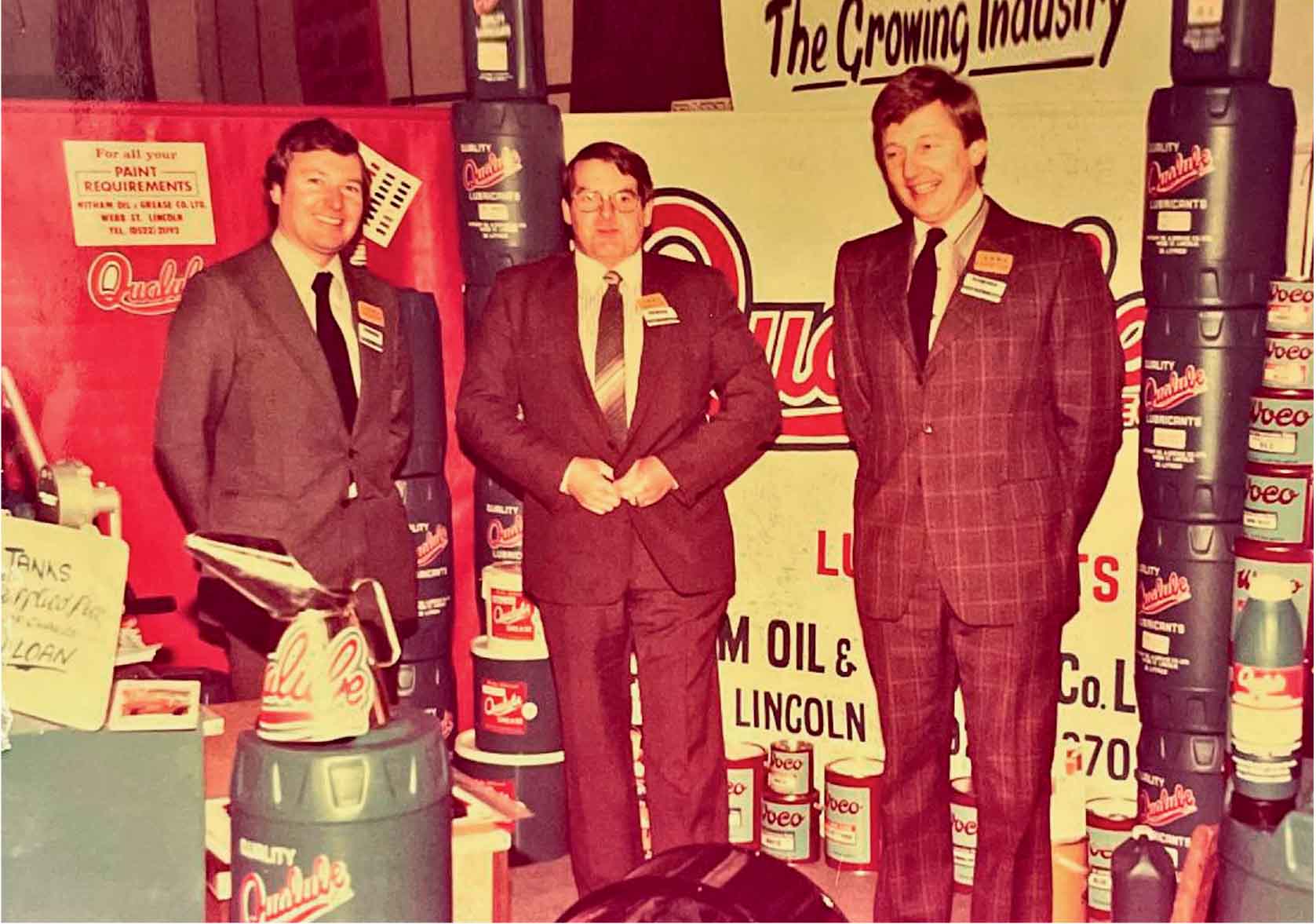
VENUE
“One man who deserves a great deal of credit for LAMMA’s early success was Joe Skehel, who through those early years managed the Lincolnshire Showground. He made sure it was an affordable venue for LAMMA so the exhibitors’ fees could be split equally and cover the costs.”
Richard adds:
“I remember going with my father to the first show. It had been snowing the day before and there were some concerns that people would not show up. It was not a big event; you could walk around the whole thing in 20 minutes. But what it did was sow the seed for something which would become very important to the Lincolnshire agricultural community.”
As LAMMA evolved, the names of committee members would not only include Mr Marshall, Mr Larrington, Mr Barber and Mr Bottom, but later add Ken Wootton, Ann Armstrong, Chris Armstrong, Cliff Preston, Mr Sartain, Robert Willey, Graham Hartley, Tony Lighton and David Baggaley to recall but a few. And as LAMMA grew, these dedicated people and many more like them, would devote endless hours contributing to its success.
Traditionally, with the exception of the Royal Smithfield Show, the UK agricultural show circuit dominated the summer months – yet the date chosen for the LAMMA Show was the end of January. This was a prudent decision, as January was the quietest month for many farmers and contractors and by the end of the month, the pheasant shooting season was almost over. Furthermore, it enabled not only the farmer or business owner to attend the event, but also the people who worked for them.
Former LAMMA commercial director Mr Preston says:
“This was extremely important, because for the first time, farmers could involve their employees in the decision-making process for buying new machinery. In addition, the show would ultimately attract farmers and contractors from all over the country who were looking for new ideas and ways of improving their farming businesses.”
FREE ENTRY
During the next decade, LAMMA remained very much a Lincolnshire show, which gradually attracted an increasing number of exhibitors, and more and more farmers. After all, what was there not to like? The show offered both free parking and free entry. It was a low-cost day out and an opportunity to meet local machinery firms and find out more about what was new in the Lincolnshire machinery industry. By 1993, LAMMA had expanded sufficiently where it was deemed necessary to build another exhibition hall at the Lincoln showground. The hall opened in 1994. However, as the reputation of LAMMA started to snowball and the show grew progressively larger, in 1996 the committee made the decision to move the event to the Newark Showground in Nottinghamshire.
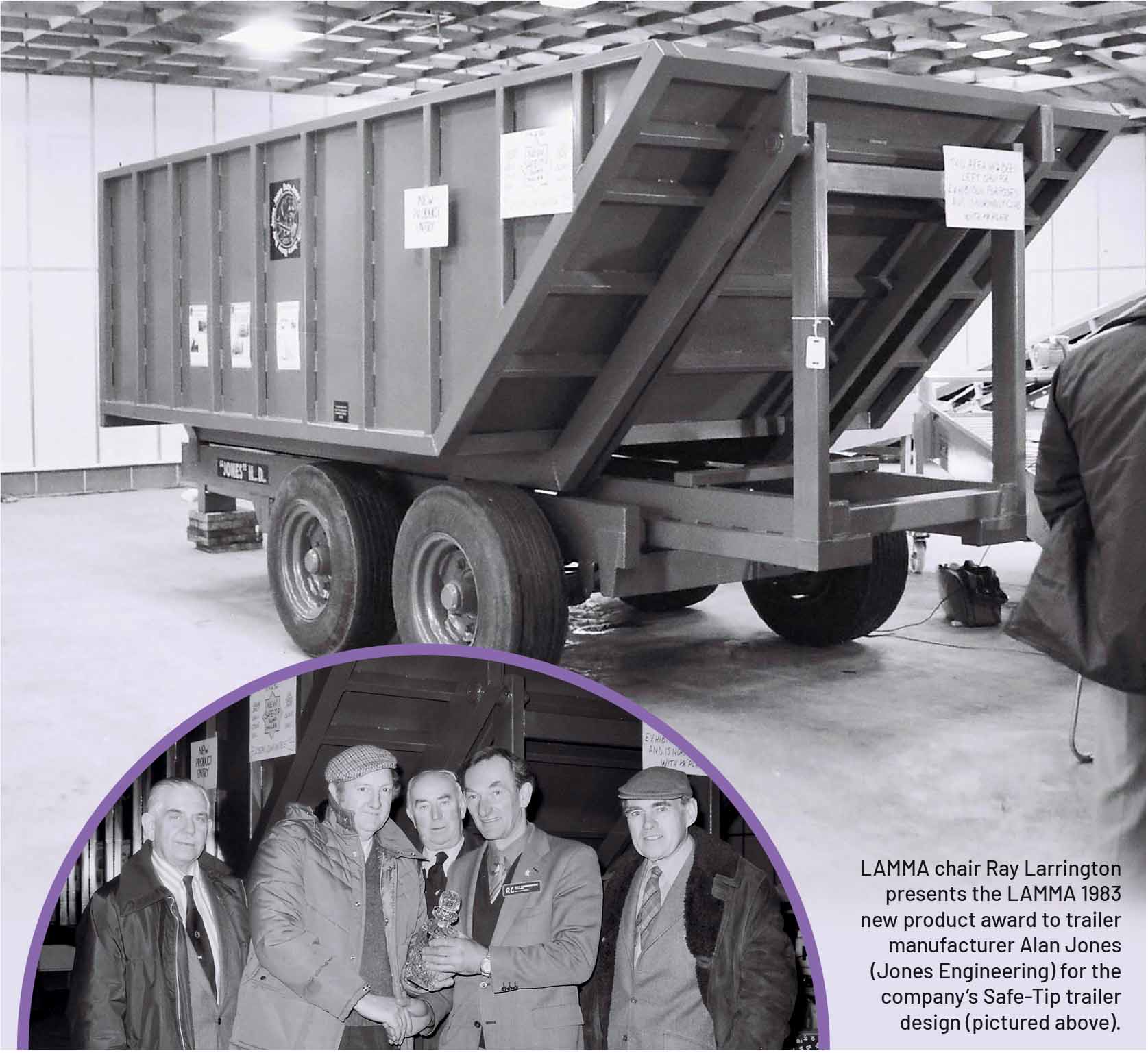
DECISION
Not everyone approved of this departure. Mr Larrington reportedly wanted the show to remain in Lincolnshire and, following the majority decision of the committee to move to Newark, he resigned. For the record, he would later return and eventually retire as president.
By moving to Newark, two things happened. Firstly, because the show was now outside of Lincolnshire, it began attracting smaller companies from neighbouring counties. Secondly, Newark Showground was more accessible than Lincolnshire Showground, which made it easier for farmers and contractors from further afield to attend the event.
But it was not just the venue which was changing. New people were also getting involved. Mr Sartain had started his career in the early 1960s as an agricultural engineering and machinery lecturer travelling around the country. His role involved working with manufacturers and educational facilities to teach farmers and dealers about new techniques and improved methods of mechanised farming.
“Eventually, my involvement in teaching agricultural engineering had capped, with little prospect of further promotion,” says Mr Sartain. “So I decided to take a position in El Salvador, where I spent the next four years. When I returned to the UK, I worked for the Agricultural Training Board (ATB) as the head of training services, which included research and development. This worked well for several years, however Government cutbacks at the dawn of the 1990s placed huge pressure on the ATB, so like many others, I moved on. Around this time, after I had become a self-employed training and management consultant, I moved from the South East to the Newark area. This is when I first attended LAMMA. I was very impressed. Not only was it free entry, but there was a wide variety of machinery and equipment being showcased. I have always been interested in development work,” adds Mr Sartain. “And with two colleagues, I had established a new precision farming training business. The following year I exhibited the business at the LAMMA Show and it was while I was working on my stand, Mr Barber approached me and asked if I would like to join the LAMMA committee. I had met Mr Barber and Mr Marshall some years before, as we were all members of the Agricultural Machinery Lecturers Association. Having agreed to become involved, Mr Barber put my name forward to be a committee member. This was duly seconded and I was voted onto the committee. Initially, my skill set got me involved in the paperwork for the organising committee, however, within a short time I became involved with the various awards, competitions and the scholarships which would be supported by LAMMA in the following years.”
SUCCESSFUL
Mr Preston was working for Lincolnshire-based agricultural engineering firm Richard Pearson when LAMMA was founded. Pearson was a large company, which imported Grimme harvesting equipment from Germany. It was a very successful business, however because it was importing German machinery, it was not eligible to exhibit at LAMMA. Mr Preston says:
“I left Pearson to become a freelance agricultural journalist and public relations agent. I knew Mr Marshall and we had talked about the continued need for an agricultural event geared towards smaller manufacturers. It was a concept which I personally felt remained a necessity, if many smaller companies were to survive within the industry. I got involved with LAMMA in 1997 when the show moved to Newark. Having worked in public relations for several smaller
manufacturers, I was given the responsibility for sales and marketing. From this I went on to selling stands, during which time I developed strong relationships with both exhibiting manufacturers and the media. As the show got bigger we attracted more media attention, which promoted the show to readers of the farming press on a wider scale. At Newark, the show had become an event for exhibitors outside of Lincolnshire and not just manufacturers. We started attracting seed merchants, agronomists, consultants representing fertiliser and pesticide manufacturers and banks offering financial advice and loans. However, what remained important was many of the original manufacturers who had exhibited in the beginning, continued to exhibit year upon year. The attraction to LAMMA was the exhibitors’ fees were around one-third of those for the big national shows. However to remain successful, we had to make our entire income for the year in just two days. This meant we relied on the efforts of the show committee, and also the event staff, most of whom worked voluntarily without pay.”“The biggest boost to the success of LAMMA was the demise of the Royal Smithfield Show in December 2004,” adds Mr Preston. “This had been the premier agricultural event of British agriculture and suddenly many large manufacturers had lost their national stage. LAMMA provided that stage and from 2005 onwards, the event would achieve nationwide acclaim.”
The cessation of the Royal Smithfield Show encouraged many of the big guns in the British agricultural tractor and machinery industry to take on LAMMA as a national exhibition platform. From 2005 onwards, companies including John Deere, CNH and AGCO would become frequent exhibitors at LAMMA.
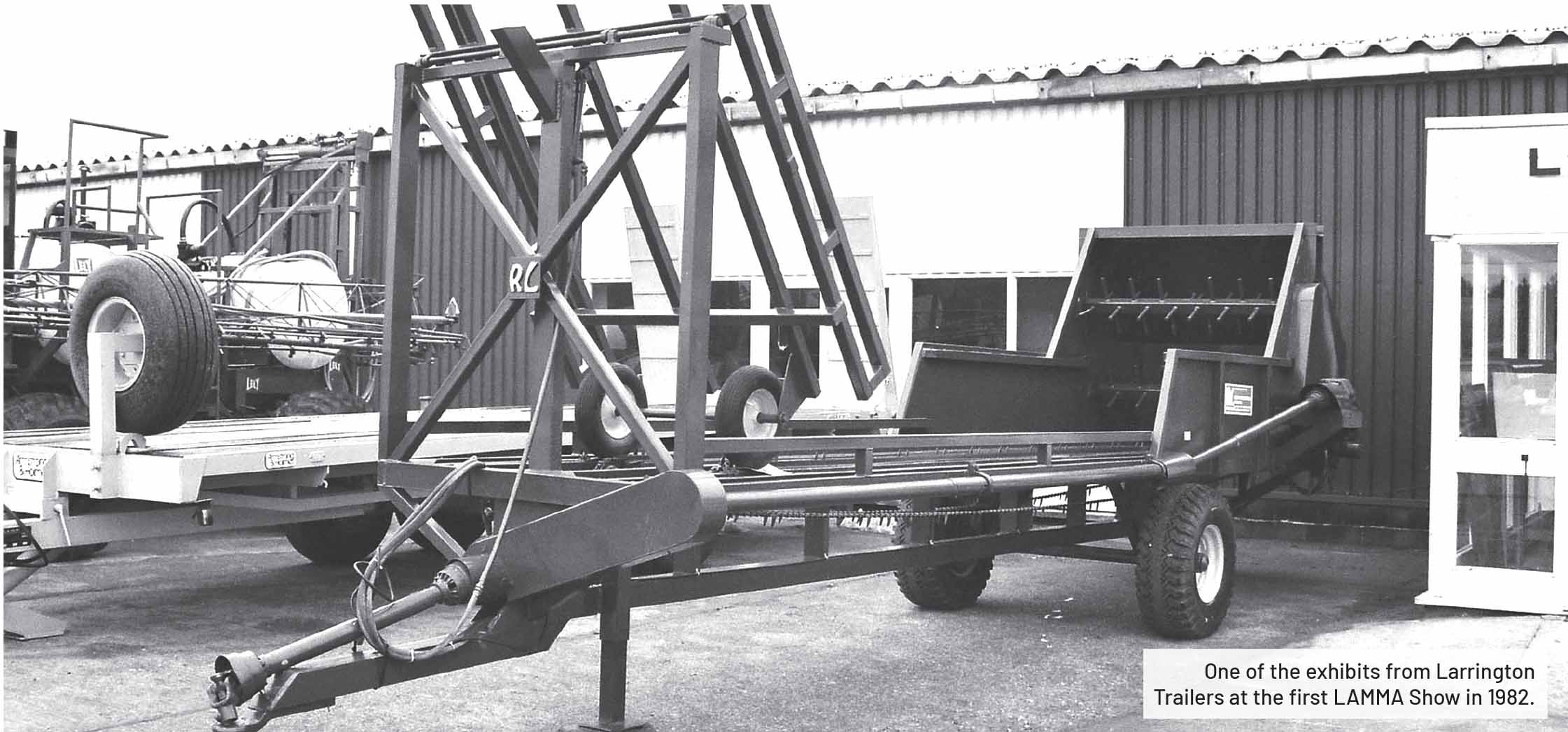
FACILITIES
For show organisers, the media attention the larger manufacturers brought with them was a welcome boost. But providing facilities for these exhibitors was not without its challenges. The main difficulty was that the larger companies required a significant increase in stand space and factors such as a reliable electricity supply to power the bigger exhibits. Additionally, the big manufacturers also required marquees to encompass their much larger displays, which frequently included large-scale harvesting equipment, tillage machinery and high-horsepower tractors.
Marquees provided protection from the weather, and also extended the daylight hours during the depths of winter. Yet as the show expanded, providing dozens of marquees for the increasing number of exhibitors became the LAMMA committee’s biggest expense.
Steve Mitchell, who’s ASM Public Relations represented John Deere for 30 years, says:
“LAMMA was still a low-key event when I first went there with John Deere. We were the public relations agency for John Deere at the time and, if I am being honest, LAMMA was widely considered an event for smaller manufacturers. Back then Cereals was a bigger event for us, however, in time, LAMMA seemed to ascend in popularity and made its place in the show calendar. In some respects, I think the arrival of big companies like John Deere initially squeezed out the smaller exhibitors. However this was overcome to a larger extent by the organisers, who provided additional marquees for the smaller stands.”
There was no denying LAMMA had outgrown the Lincolnshire Showground when it moved to Nottinghamshire in 1997. In just 15 years it had grown threefold, attracting 150 exhibitors during its debut at the Newark Showground. The former airfield at Newark would become the home of LAMMA for the next 18 years, but eventually it too would be outgrown by the show’s success.
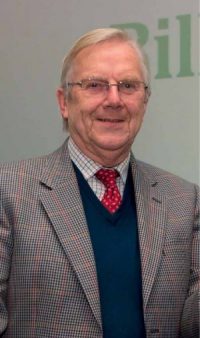
Mr Sartain says:
“At first, Newark proved to be the perfect choice. However as the show increased in size and more of the larger manufacturers joined the list of exhibitors, we soon experienced some new challenges. “As a facility, Newark was excellent. It had lots of nearby parking space, much of which was on hard standing. Inside the showground, which stood on light free-draining land, the concrete runways and service roads provided an ideal network along which we could deploy the ever increasing number of exhibitor marquees. The problem with Newark, was that although it was centrally located within the UK, the surrounding road network could not cope with the traffic. Newark was a small market town and with the showground nearby, there would be traffic jams in all directions for miles. The other issue was the lack of hotels and restaurants in the area to meet the demand of both exhibitors and visitors.In later years, one of the ways we overcame the traffic issue was to open the showground at 6.30am, which reduced the impact on local commuter traffic. To support this decision, we introduced the early-bird breakfast scheme, so people arriving at the show early could have a coffee or a cooked breakfast. The cost of this service was subsidised by LAMMA and it actually became popular with some local people in the area who would stop off on their way to work.”
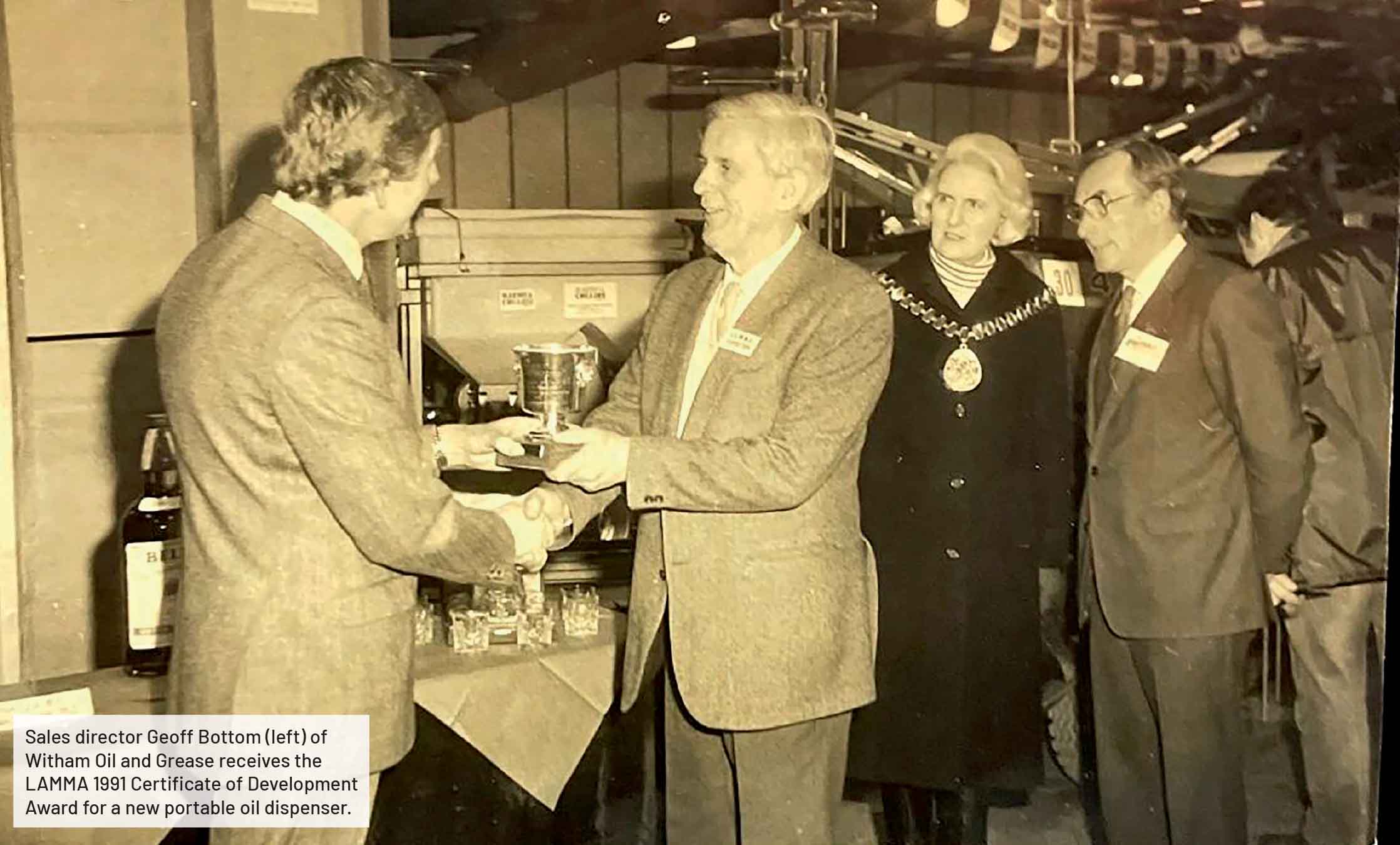
AWARDS
During his tenure with LAMMA, one of Mr Sartain’s responsibilities involved both organising and orchestrating the many award schemes supported by LAMMA. He says:
“Organising the LAMMA awards and competitions involved a huge amount of people time. I would organise all the sponsors, the judges and the presentation of the prizes the winning participants would receive. From my point of view, the innovation award was something I was particularly proud of. Trying to help young people with new ideas and steering them towards success was something which really interested me, particularly as I had spent a great deal of time working to support young people’s development myself.”
One of the many young inventors who would achieve success, following the debut of his onTrak GPS guidance system at LAMMA, was Berkshire native Adam Keene. Having spent several years developing a portable GPS tracking device, Mr Keene attended the LAMMA Show in January 2017, where his company
Agricision debuted the onTrak system to the public. Mr Keene says:
“We only had prototype units on display. However, we promised those people who were interested in the system that we would deliver any pre-orders made at the show by March. In two days we took 15 fully pre-paid orders. To my delight, the onTrak system won the LAMMA 2017 Innovation Award. The day after LAMMA, I was at Punchestown in Ireland, meeting Irish farmers and dealers who had contacted us on Facebook. There was huge interest in the onTrak system and orders immediately started coming in. Within three days of launching onTrak at LAMMA, we were selling it in two different countries. It was an exceptional moment in my career.”
Mr Sartain was elected as LAMMA chair in 2010, following the resignation of friend and colleague Mr Lighton. By this time LAMMA had firmly established itself as a guiding light in the UK farm machinery sector, however maintaining the course for continued success was increasingly challenging for the organising committee.
This was the same year LAMMA entered negotiations with Briefing Media, a publishing concern which had purchased Farmers Guardian and its sister titles Dairy Farmer and Arable Farming. Mr Sartain says:
“We initially had our reservations about choosing Briefing Media who wanted to use FG to sponsor the show. However during our negotiations we established a mutually good relationship, as it became evident the publisher wanted to retain the original ethos and business model for LAMMA, established by the founding committee. By doing this, Briefing Media would improve the stance of FG as a machinery and arable farming publication, while simultaneously providing greater publicity for the show. For the most part, this is what they were able to achieve and I believe the sale of LAMMA to Briefing Media in 2012 was undoubtedly the right thing to do at the time.”
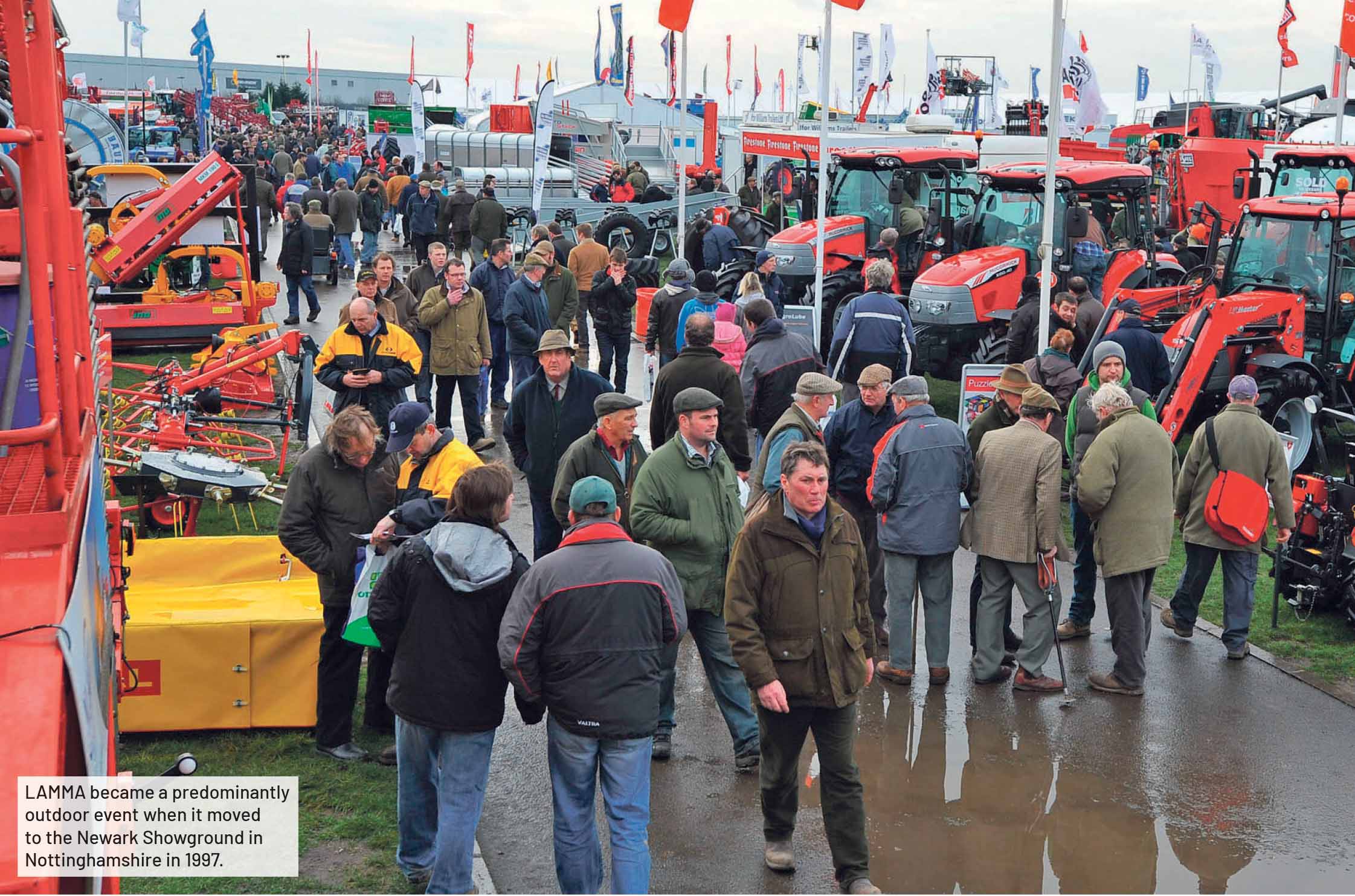
ENTHUSIASM
With Briefing Media at the helm, the success of LAMMA soon sky-rocketed. Injected with the enthusiasm of both new management and editorial teams, LAMMA’s association with FG attracted more exhibitors and more spectators than ever before. Mr Preston says:
“At LAMMA in 2015, which was the final year for the show at Newark, there were 900 exhibitors and more than 40,000 people attending the show. “Following the 2015 show, it was evident LAMMA had outgrown the Newark Showground, so it was decided to move it to the East Of England Showground at Peterborough. We were still seeing an increasing range of equipment being showcased by smaller manufacturers who were willing to be positioned alongside the major manufacturers. Additionally, there was an increasing number of farm merchants and consultants wanting to exhibit at the show. In 2018, we introduced an area within the show which for the first time was dedicated to businesses which supported the wider needs of farmers. This was also the last year the show was hosted at Peterborough.”
The move to Peterborough was arguably a necessity from the perspective of Briefing Media. With more access points into the showground, a better outlying network of roads and more local hotels and restaurants, the Peterborough Showground also boasted a larger crowd capacity. But it had one inherent flaw. Where the Newark Showground stood on light sandy ground, the East of England stood on heavy clay soil. In the rain, the entire area quickly became saturated, which produced large areas of wet ground which quickly turned into liquid mud once spectators started pouring into the showground. Since this was a predominantly agricultural show, many of the visiting farmers and contractors came equipped for the ground conditions, yet for many exhibitors and their staff it was a different story. To make matters worse, the wet conditions made tearing down the exhibitor’s stands after the show a challenge for everyone concerned. This included the owners of the showground, who were left to refurbish the site, albeit at LAMMA’s expense.
The hammer blow for LAMMA at Peterborough Showground came in 2018, when high winds caused damage to several marquees at the event, forcing the organisers to close the show down on the second day. Yet while it briefly seemed as if the future of LAMMA might be in the balance, it was soon announced the show would return on a scale never before seen, at the NEC in Birmingham. LAMMA made its debut at the NEC in January 2019. Hosted in the vast display halls of this magnificent facility, exhibitors and spectators alike embraced the warm weather-free environment which elevated the status of the show from a national to an international event, thanks to the close proximity of Birmingham International Airport.
The following year saw a return of LAMMA to the NEC, which despite the looming threat of the Covid-19 pandemic and the withdrawal of some manufacturers as a precautionary measure, remained a successful and enjoyable event. Unfortunately, the cancellation of LAMMA in 2021 came as no surprise to anyone. With Britain and most of Europe in lockdown, Covid-19 forced the cancellation of almost every single major agricultural event planned for 2021 on a global-scale. But this is not where the LAMMA story ends.
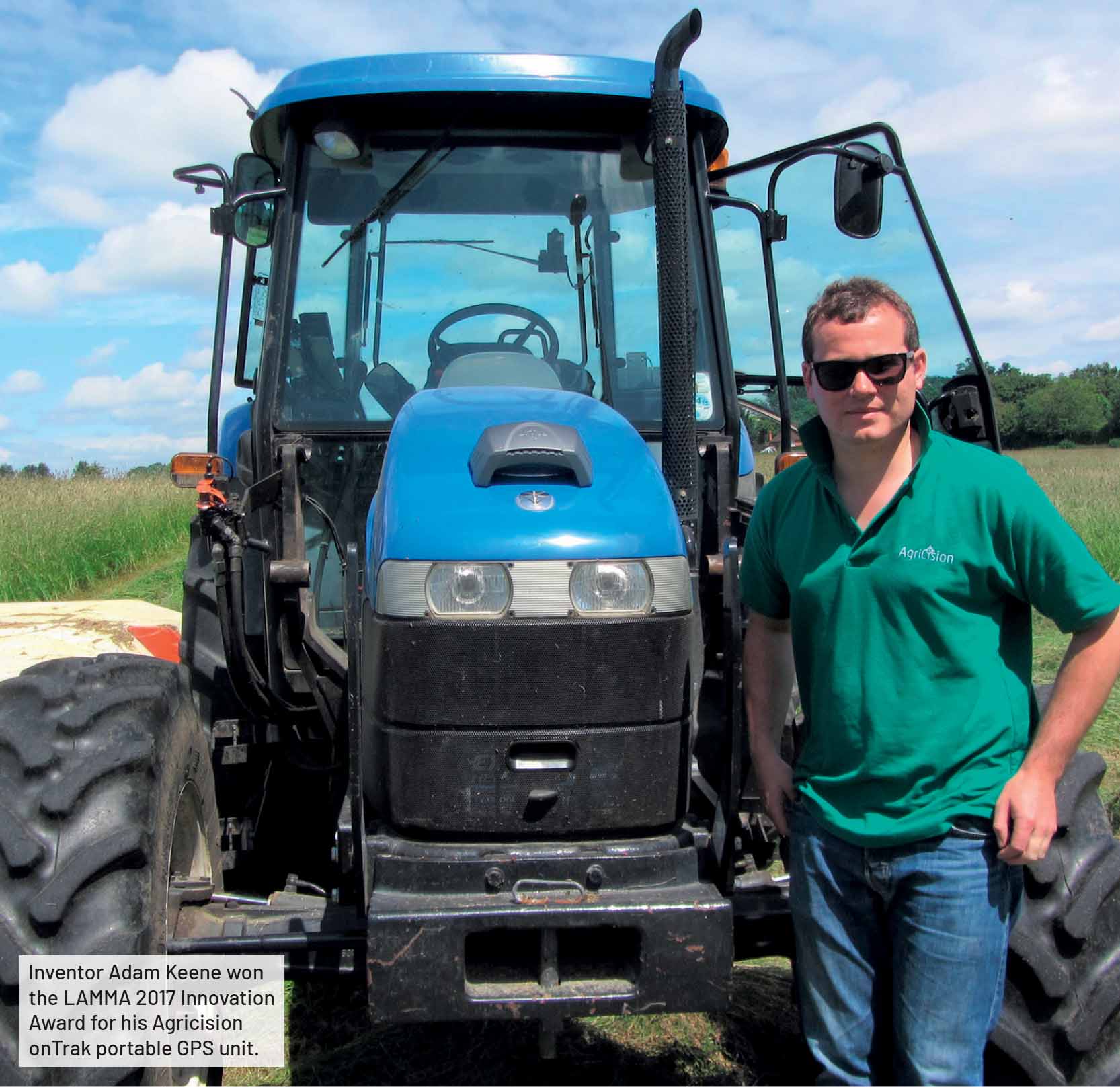
A NEW ERA
As LAMMA celebrates its 40-year anniversary, the show also embraces new ownership, following the 2021 purchase of FG and LAMMA from AgriBriefing (formerly Briefing Media), by Agriconnect. Mr Preston says:
“LAMMA has now become a national institution. My personal hope is that the new owners will retain some of the original formula established by its founders, so LAMMA can continue to be an affordable platform for upcoming businesses and small manufacturers to exhibit new developments in agricultural machinery and technology.”
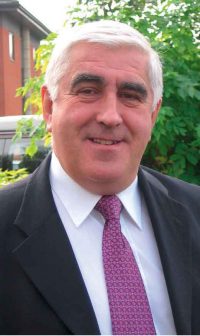
Richard says:
“I remember exhibiting at the Royal Smithfield Show when 120,000 people would attend the event at Earls Court. Having watched LAMMA progressively grow over the years, I was a huge advocate for moving LAMMA to the NEC. LAMMA needed to become an indoor event and I firmly believe the NEC is the right place for LAMMA to be in the future.“This is the foremost agricultural show in Britain today and I hope to be exhibiting at the show for many years to come.”
The Witham Group is very proud of Geoff Bottom’s involvement in creating this show, and it has been wonderful to see it grow from a small Lincolnshire show, to one of the largest agricultural shows in the UK today.





Leave a Reply